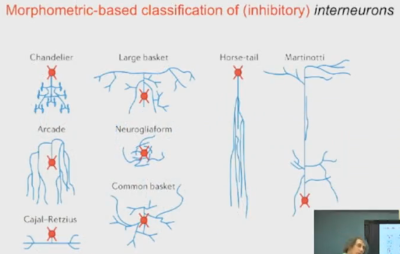Neuron
Neuron can be conceptually viewed as an input-output electric device where dendrites are the input device and the axon is the output device.
 |
| Figure 1: Neuron as an I/O Device. |
Axon
The axon is the output electrical device of neurons. It generates and carries electrical signals called "spikes".
- A single, highly branched, thin (um) process emerging from the soma.
- At the "hot" axon initial segment (AIS) the spike is initiated and then propagates along the axon.
- Covered with myelin (isolating) lipic sheath, with termittent small gaps - the nodes of Ranvier (where "hot" excitable ion channels reside)
- Decorated with frequent swelling (axonal buttons/ vericocities) where the neurotransmitter "hides" (the pre-synaptic site). An axon typically has about 5000~10,000 vericocities.
 |
| Figure 2: Typical morphology of a neuron |
Glial Cell: Surrounds the axon.
Dendrite
There are various types of dendrites -Purkinje Cell, Starburst amacrine cell, CA1 Pyramidal cell, etc.
 |
| Figure 3: Types of dendritic trees. |
Some dendrites are spiny. Dendritic spines are the regions where synapses are made on to. Typically, there are 10,000 synapse connection in a dendritic tree.
 |
| Figure 4: Dendritic Spines |
Neuron Types
Neuron can be classified based on different categories. Principal neurons project to other brain regions, while interneurons project to local regions. Usually, principal neurons are excitatory and the interneurons are inhibitatory.
 |
| Figure 5: Principal neurons and interneurons. Red: Dendritic trees, Blue: Axonal trees. |
 | ||
| Figure 6: Morphometric-based neuron classification |
 |
| Figure 7: Spiking pattern based neuron classification |
Synapse
 |
| Figure 8: Synapse - connecting chemical between pre-synaptic axon and post-synaptic dendritic spine. |
 |
| Figure 9: Synapse - a digital-to-analogue signal converter. |
Axon and dendritic spines are separated by synapse. The axon contains small vesicles (neurotransmitter molecules). The transfer of these neurotransmitters create voltage difference in the axon and the spine. The potential in the axon cell is all or none, which is called action potential. It is like a digital signal. The potential in the spine is an analogue one. So, the synapse can be viewed as a digital-to-analogue converter.
Summary
Figure 1 summarizes all the things.
Excitatory (Red) and Inhibitatory (Cyan) axons make connection with the dendritic tree (Blue) via synapse (green). Thus the dendritic tree gets the post-synaptic potentials from the axons. All the potentials move towards the soma where all of them are summed up. If the sum of the potentials reaches a threshold, a spike is generated that moves along the axon.
Reference: Synapses, Neurons and Brains course in Coursera by Idan Segev. (link)
No comments:
Post a Comment